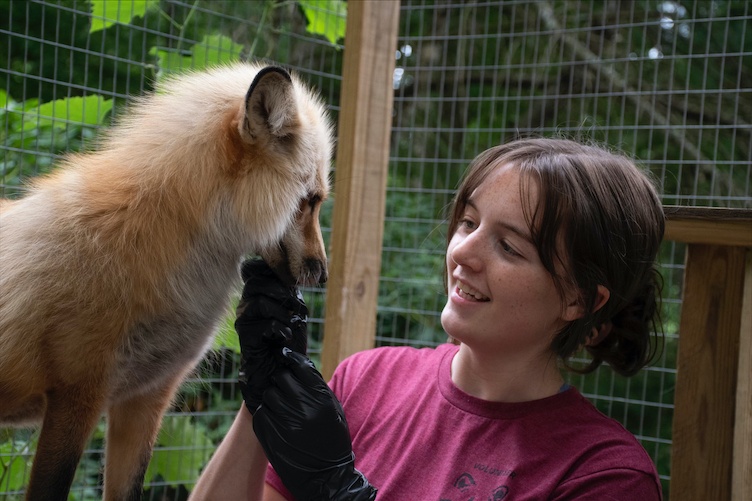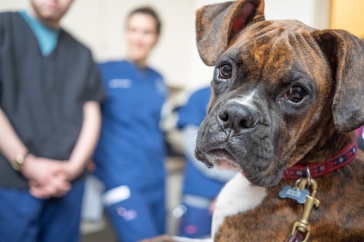
Kelsey Herold ’23 interacts with Finnegan, a non-releasable red fox living at Millstone Wildlife Center, where Herold is completing a summer internship. (Courtesy photo)
Kelsey Herold ’23 can’t wait to watch the animals she’s caring for – care that can include syringe feeding babies so small their eyes aren’t fully open yet – grow up and decide they’re frightened of her.
Herold has spent many mornings this summer cradling tiny, orphaned squirrels, many just days old, as she feeds them drops of formula. She’s been climbed on by playful adolescent raccoons and helped nurture baby opossums until they can eat solid food. In all cases, the goal is the same – help the animals grow healthy and strong enough to survive on their own in the wild.
Which is why, despite the early affectionate interactions, it’s a welcome sign when the animals begin growing leery of Herold, who is completing an internship at the Millstone Wildlife Center in Windham, New Hampshire, this summer.
“It’s pretty cool to be able to see these animals grow up from tiny little babies where we’re syringe-feeding them formula to being outside in an enclosure where they’ll soon be able to be released,” Herold says. “They need to reach a point where they’re frightened by humans, to show all the qualities they need for us to know they’ll be OK in the wild. And once they do that, they’ll be on their own.”
"There's no better feeling than helping an animal in need and then releasing it knowing it will have a much better chance of surviving once it's been cared for."
Millstone provides rehabilitation services for injured and orphaned wildlife brought to the center from throughout the state, with a goal of releasing as many as possible back into the wild. The facility also provides public education focused on coexistence with wildlife as well as additional educational outreach programs.
Herold, a wildlife conservation biology major at UNH, heard about the internship at Millstone from a classmate who had a positive experience in the same role last summer. The position has exposed Herold to animals in a variety of life stages and health conditions and has given her the chance to see several of them return to the wild after weeks or months of care.
“It’s been extremely rewarding,” Herold says. “There’s no better feeling than helping an animal in need and then releasing it knowing it will have a much better chance of surviving out in the wild once it’s been cared for.”
Not all of the animals will become releasable – those that won’t be able to fend for themselves in the wild remain on site and live in their own enclosures at the center. That population currently includes a raccoon with a neurological condition and a red fox that was raised by humans who is “extremely friendly and doesn’t think he’s a fox,” Herold says. Another fox who will stay at the center is missing one leg.
Herold has worked with animals of all sorts this summer, including squirrels, opossum, foxes, skunks, porcupines, racoons, bunnies, woodchucks, a bobcat and an otter. “Pretty much any mammal besides deer or bear,” she says.

Often the animals taken to the center have been orphaned – those who find the animals are encouraged to watch for a designated period of time to ensure the parents don’t return before the center will take them – and need to be raised from the newborn stage. Herold helped nurture a family of squirrels that arrived less than 24 hours after they were born, with eyes still closed, who needed to be syringe fed every two hours. The center will progress young animals like that from indoor living environments to outdoor enclosures to, eventually, release.
It’s not all routine, though – Herold has also seen some extraordinary survival stories. A driver who discovered a dead porcupine that had been hit by a car noticed a baby porcupine still in the placenta. By the time it arrived at Millstone, the baby had managed to move out of the placenta, and Millstone owner Frannie Greenberg’s husband, Michael, was able to clamp, cut and tie the umbilical cord and save the baby porcupine. Months later, that baby is “in great health and growing up really well,” Herold says. The center expects to be able to release it back to the wild.
Timing of a release can impact the care provided, as well. Herold noted that young raccoons set to be released in fall, ahead of their first winter on their own, need to be “fattened up” enough to survive the harshest time of year for food gathering.
Those releases remain what it’s all about for the Millstone staff. Herold, who says she’d love to work for New Hampshire Fish and Game after earning her degree, is really looking forward to the fall, when many of the animals she’s been working with all summer will be ready to set out on their own.
“I’ve learned so much about these species by watching them every day,” Herold says. “I’m super excited for the fall when a lot of these animals will be big enough and ready to be released. After caring for them for months and knowing they are ready to go out there, that’s the main goal of everything we do.”
-
Written By:
Keith Testa | UNH Marketing | keith.testa@unh.edu
















































